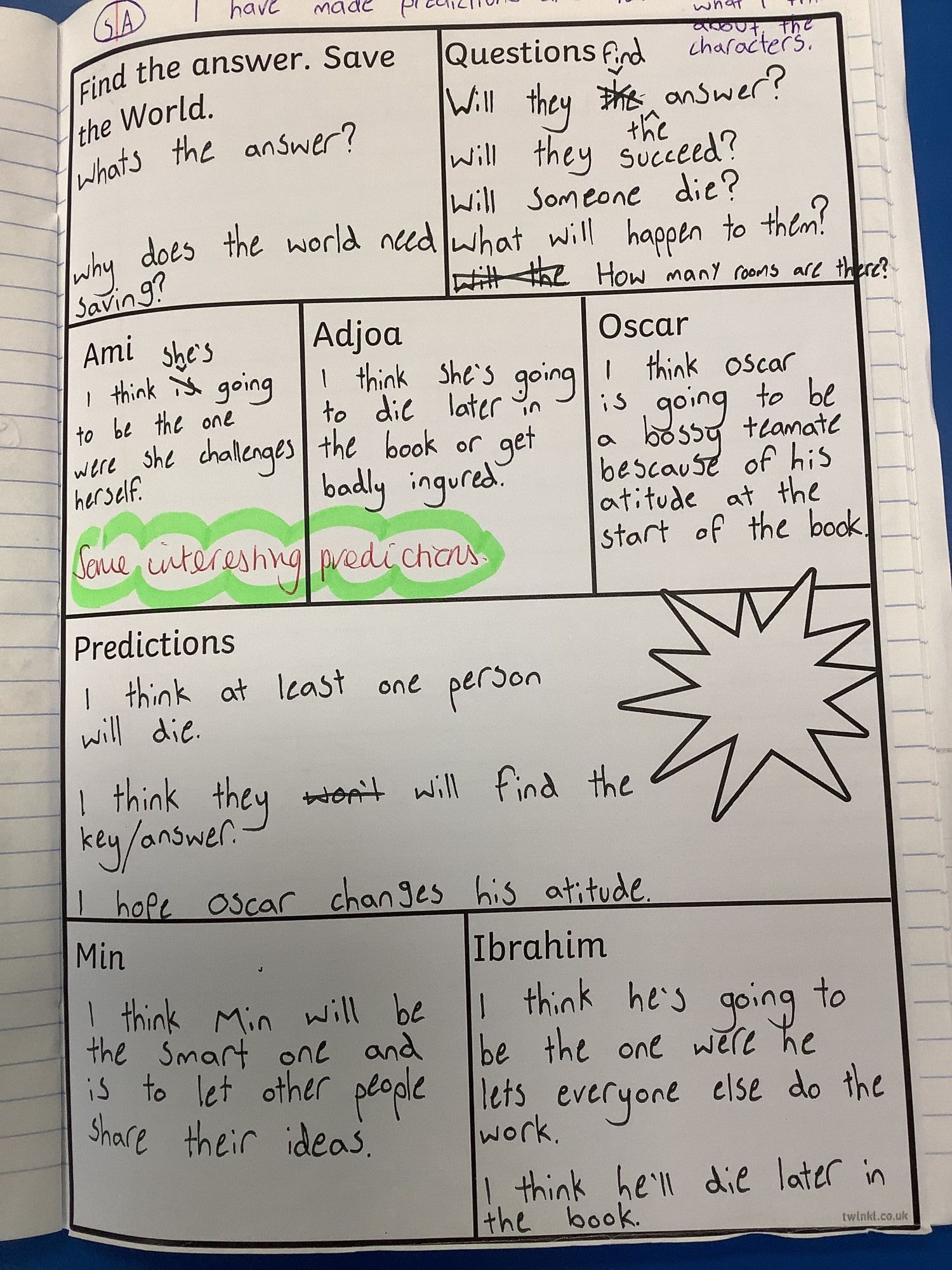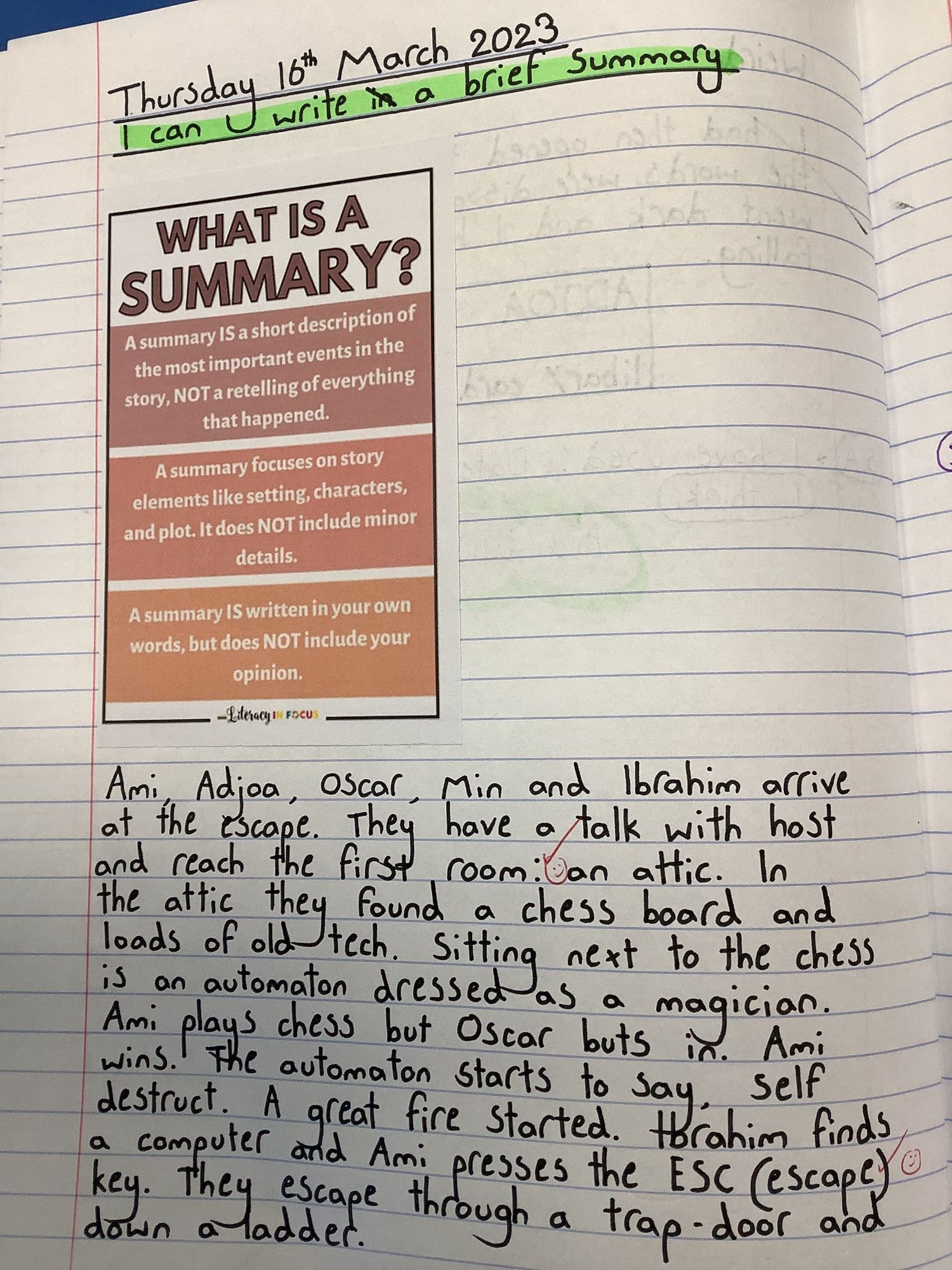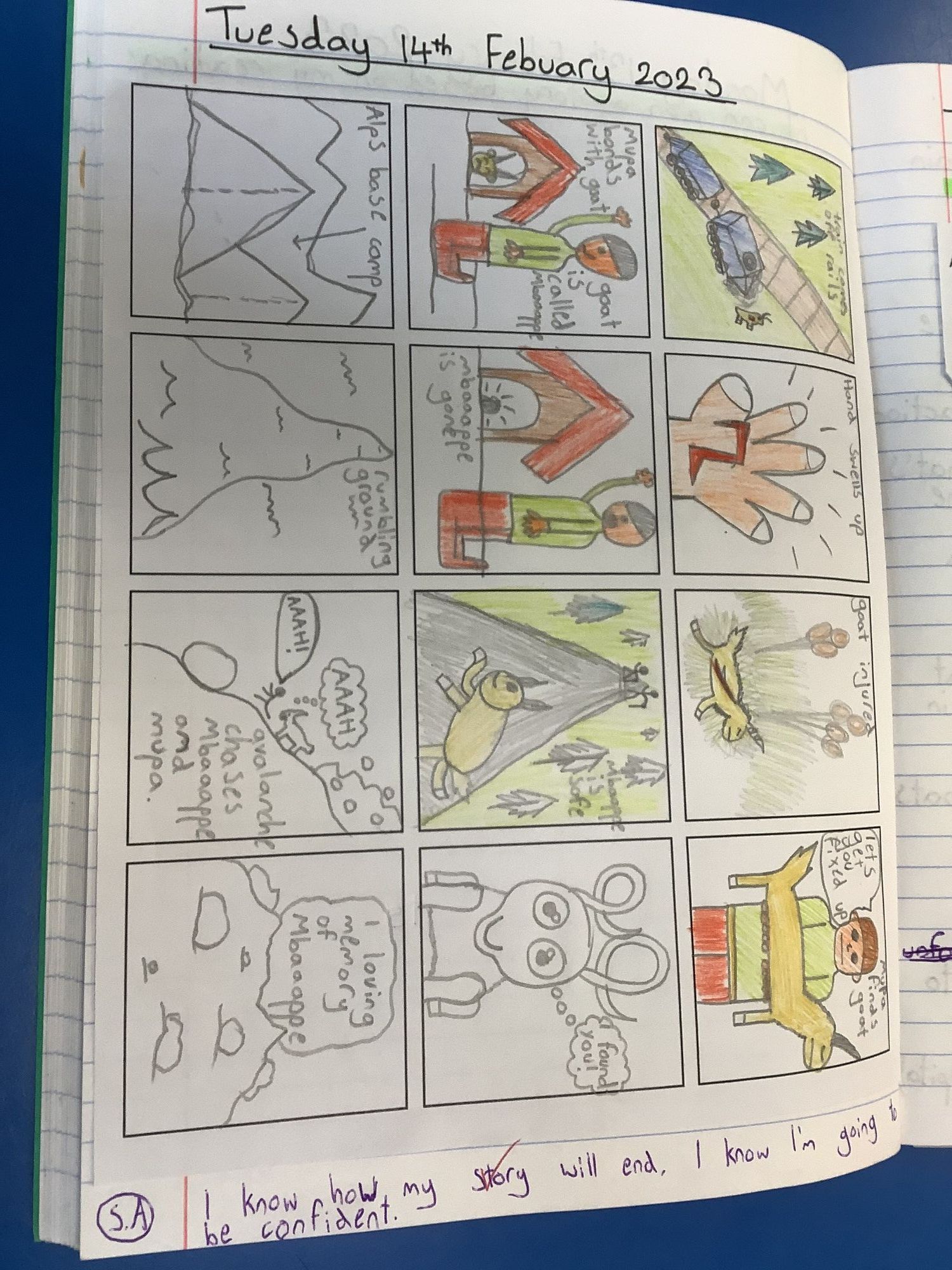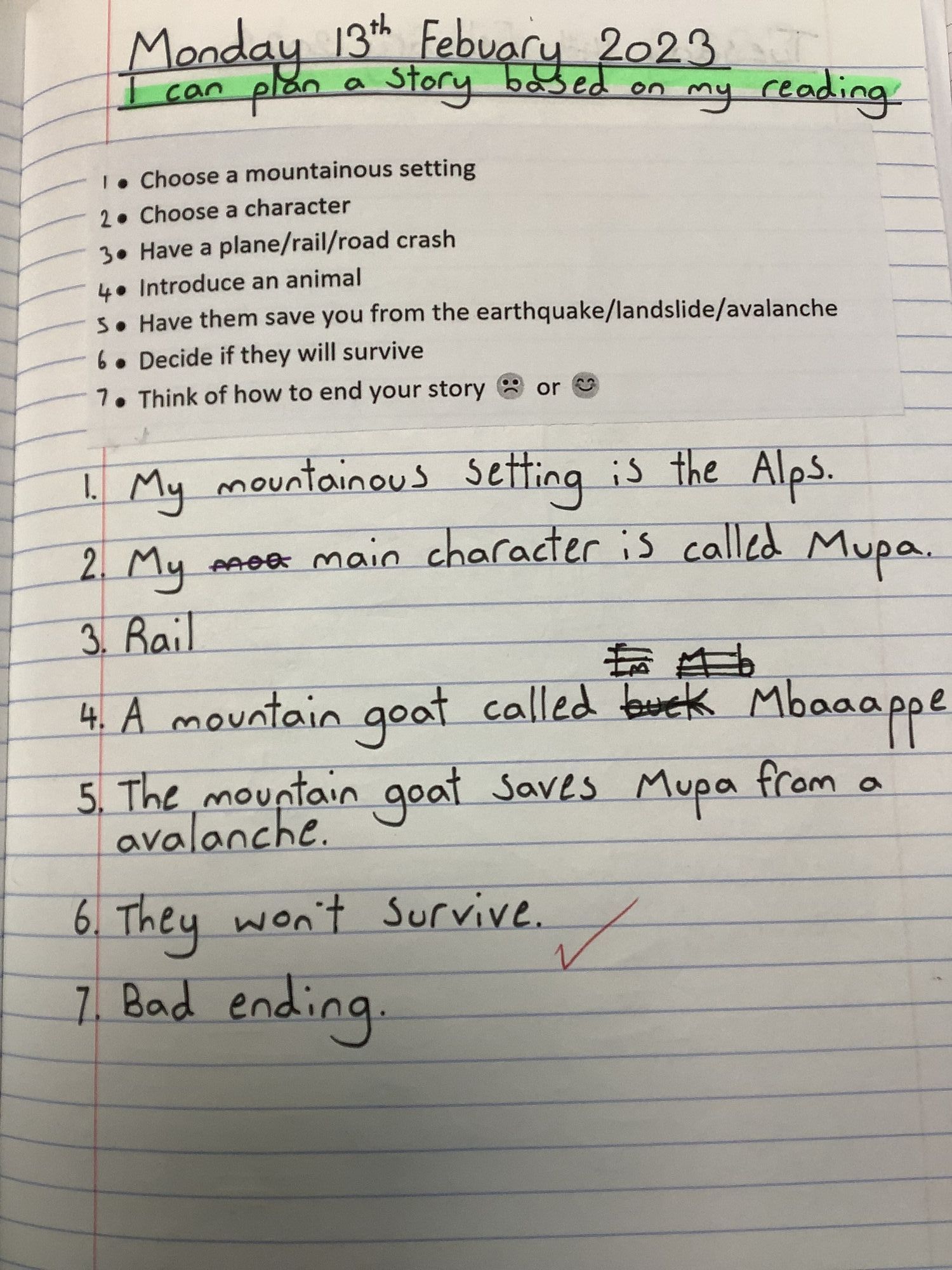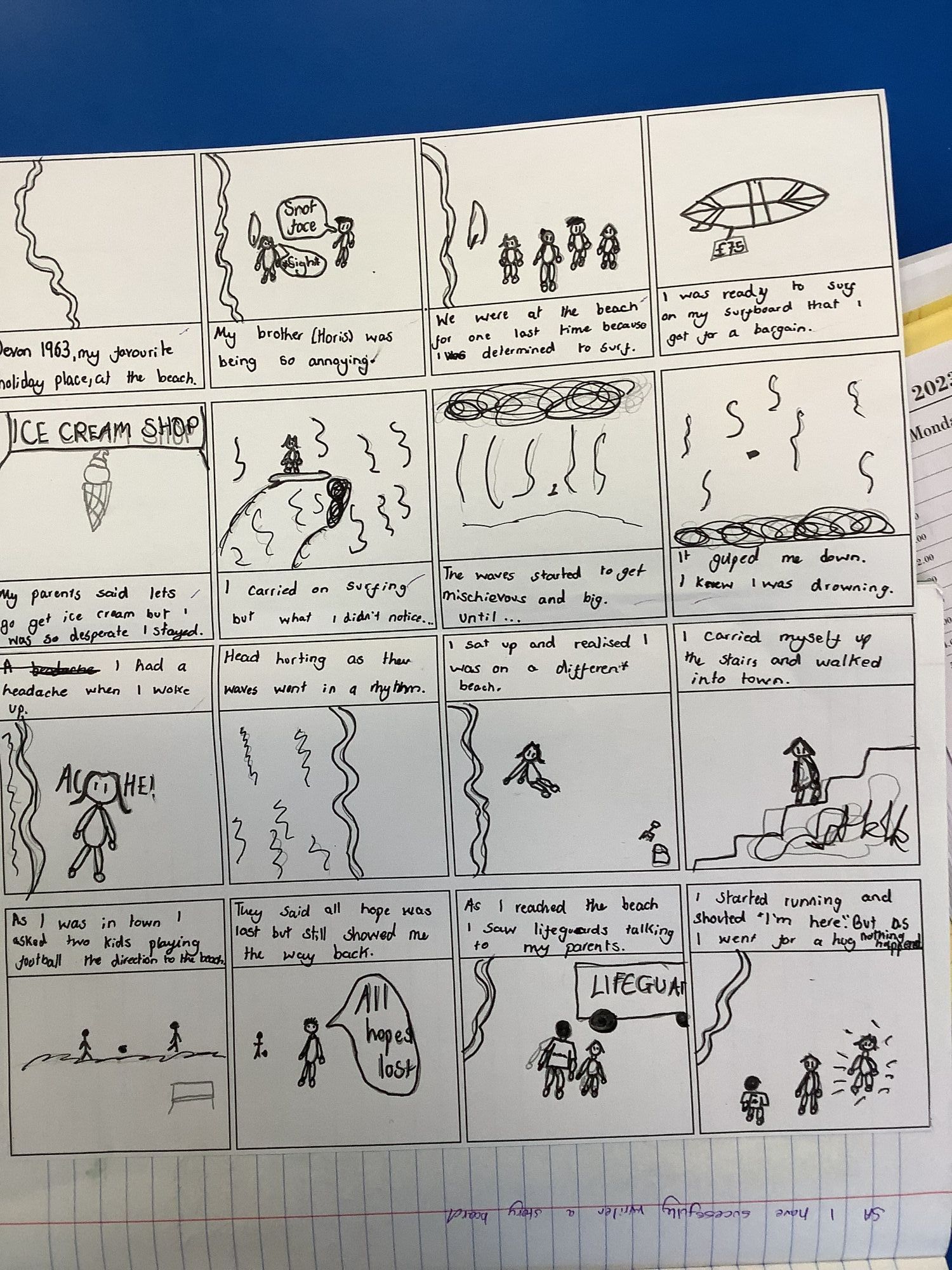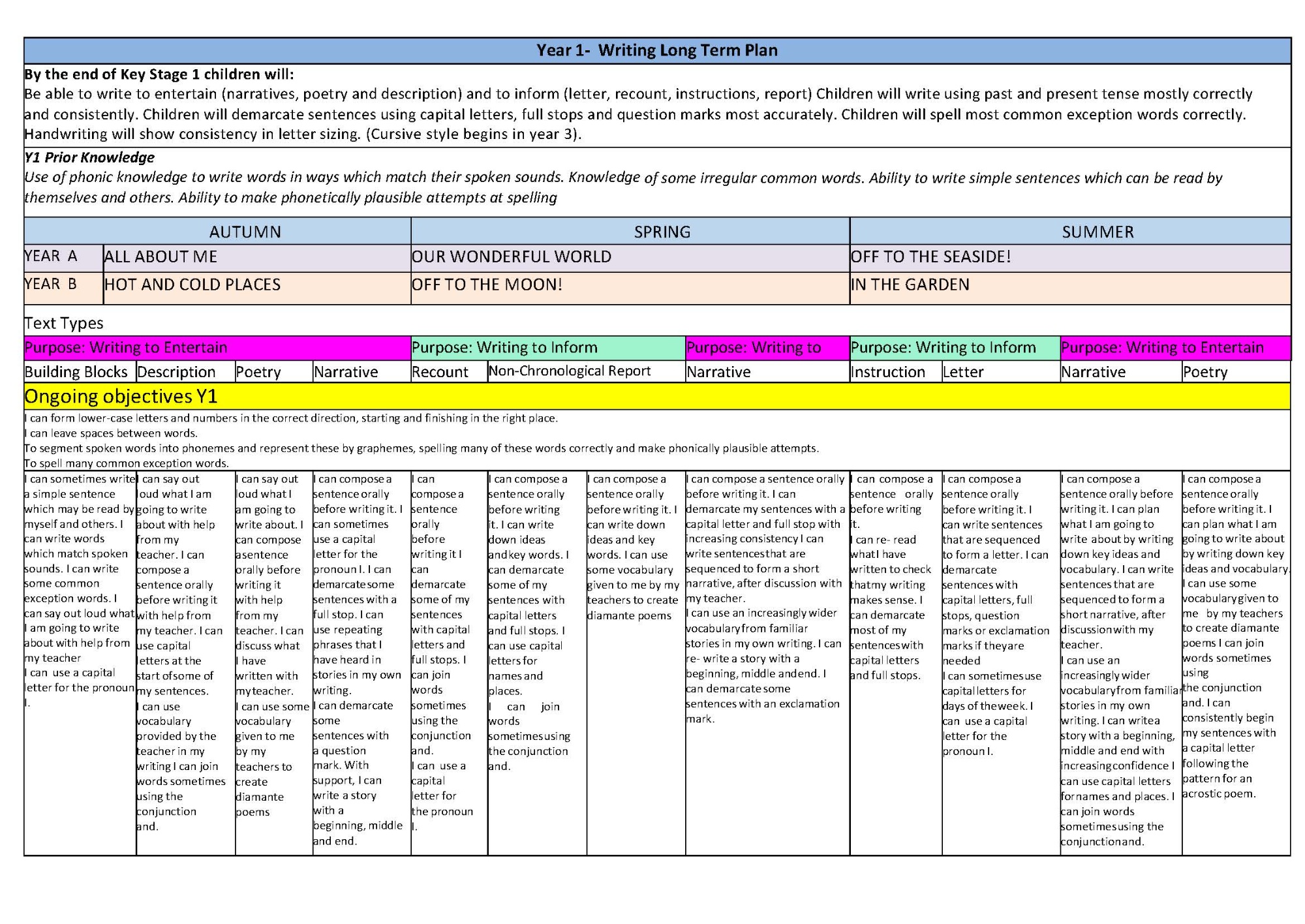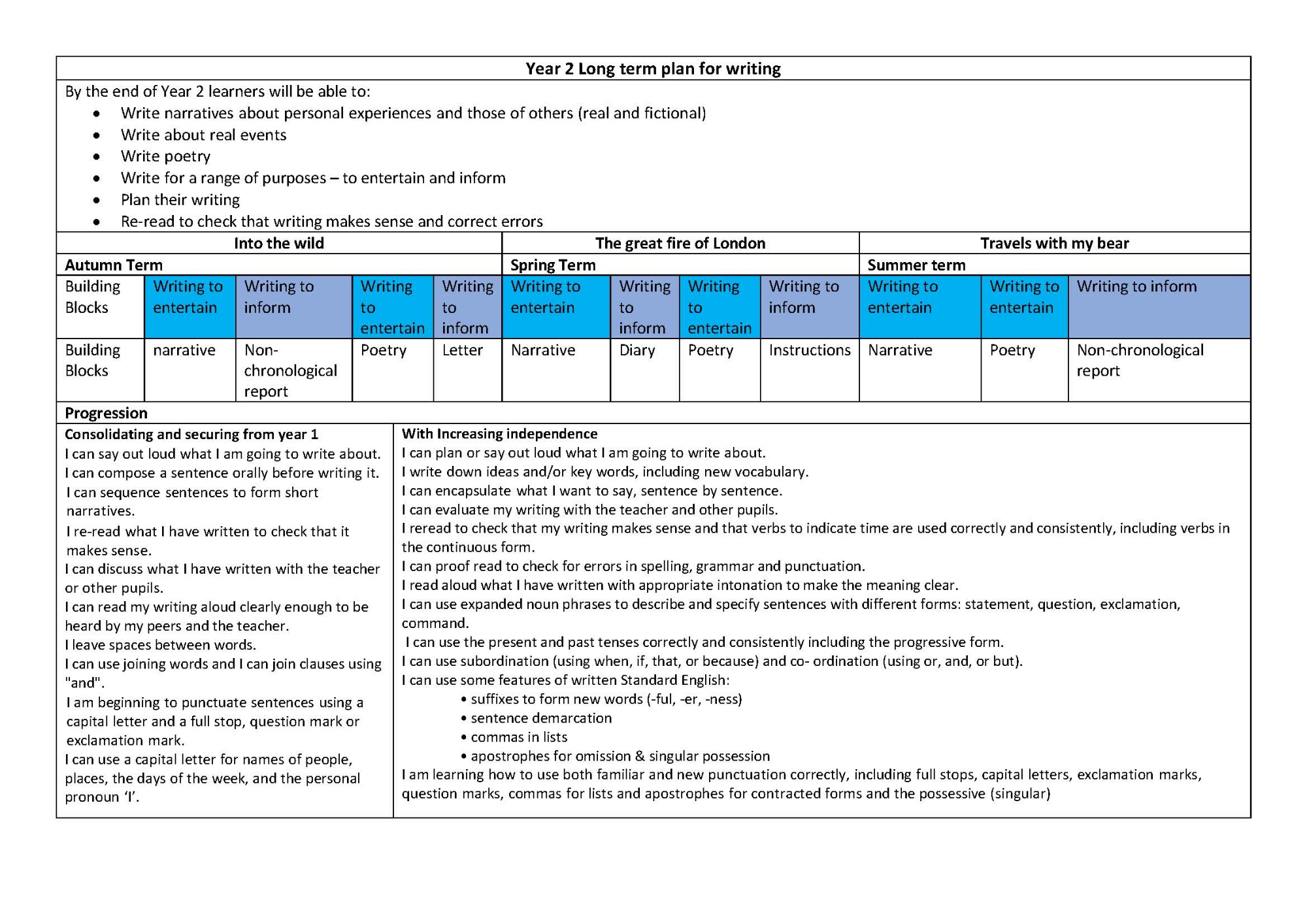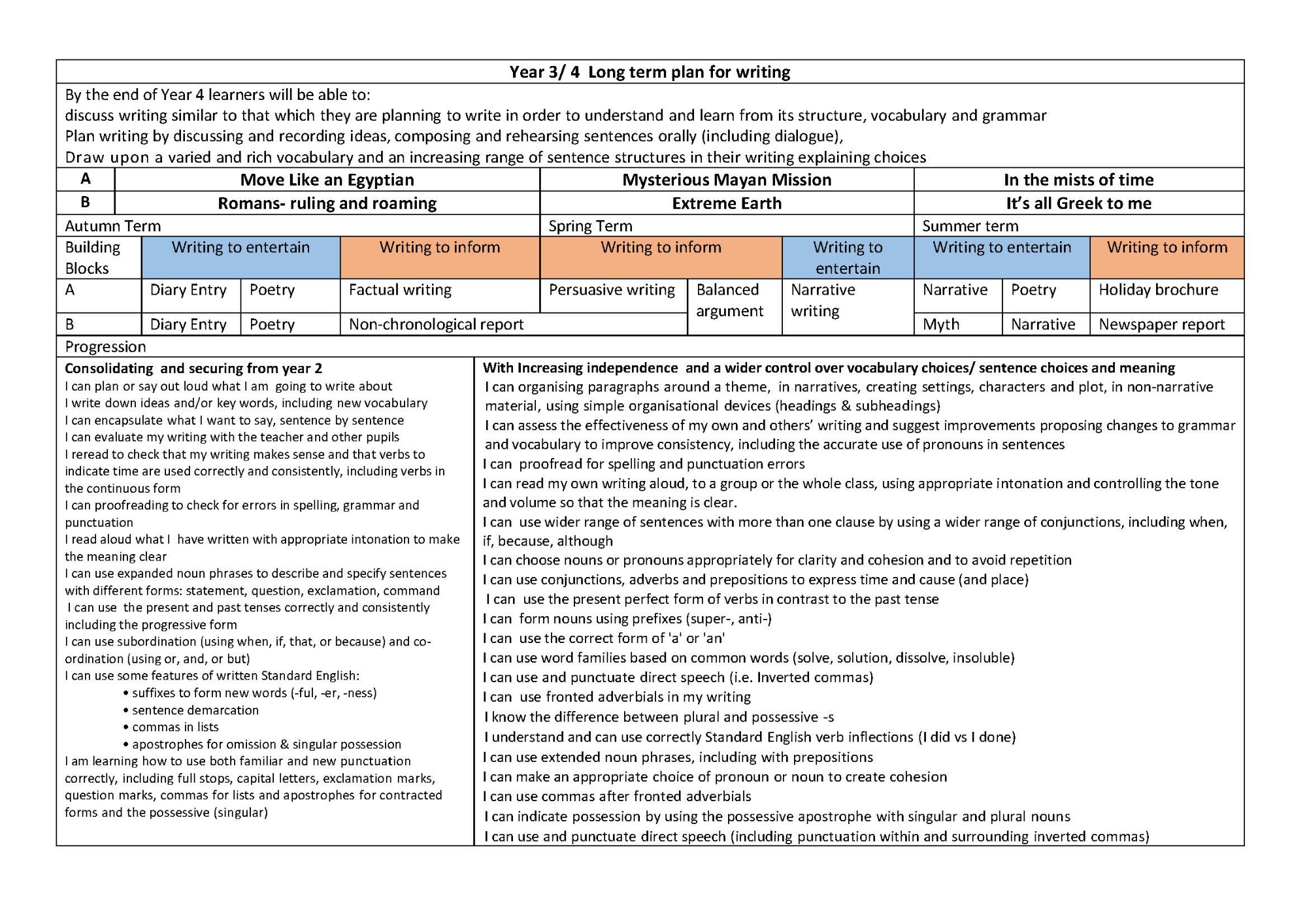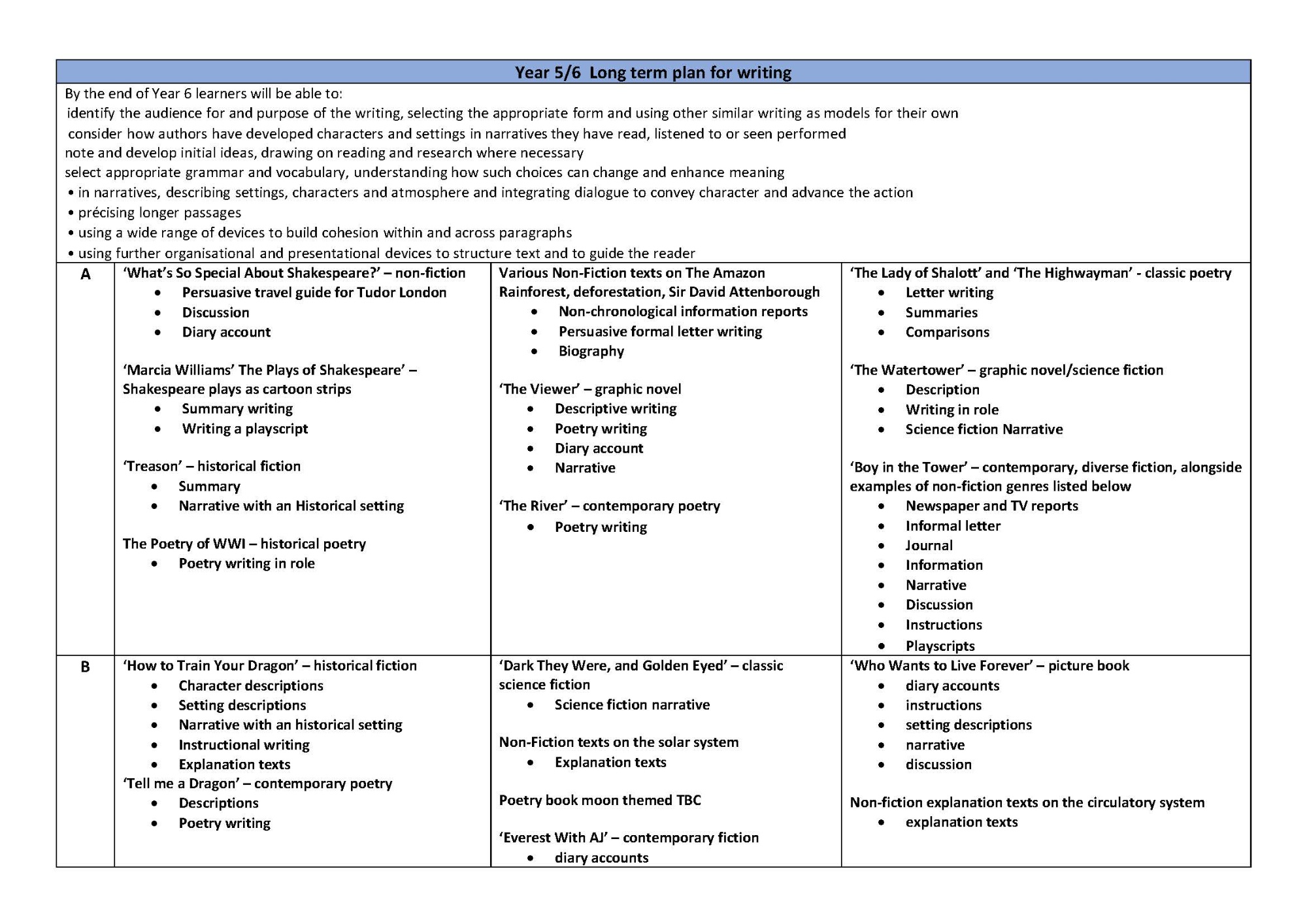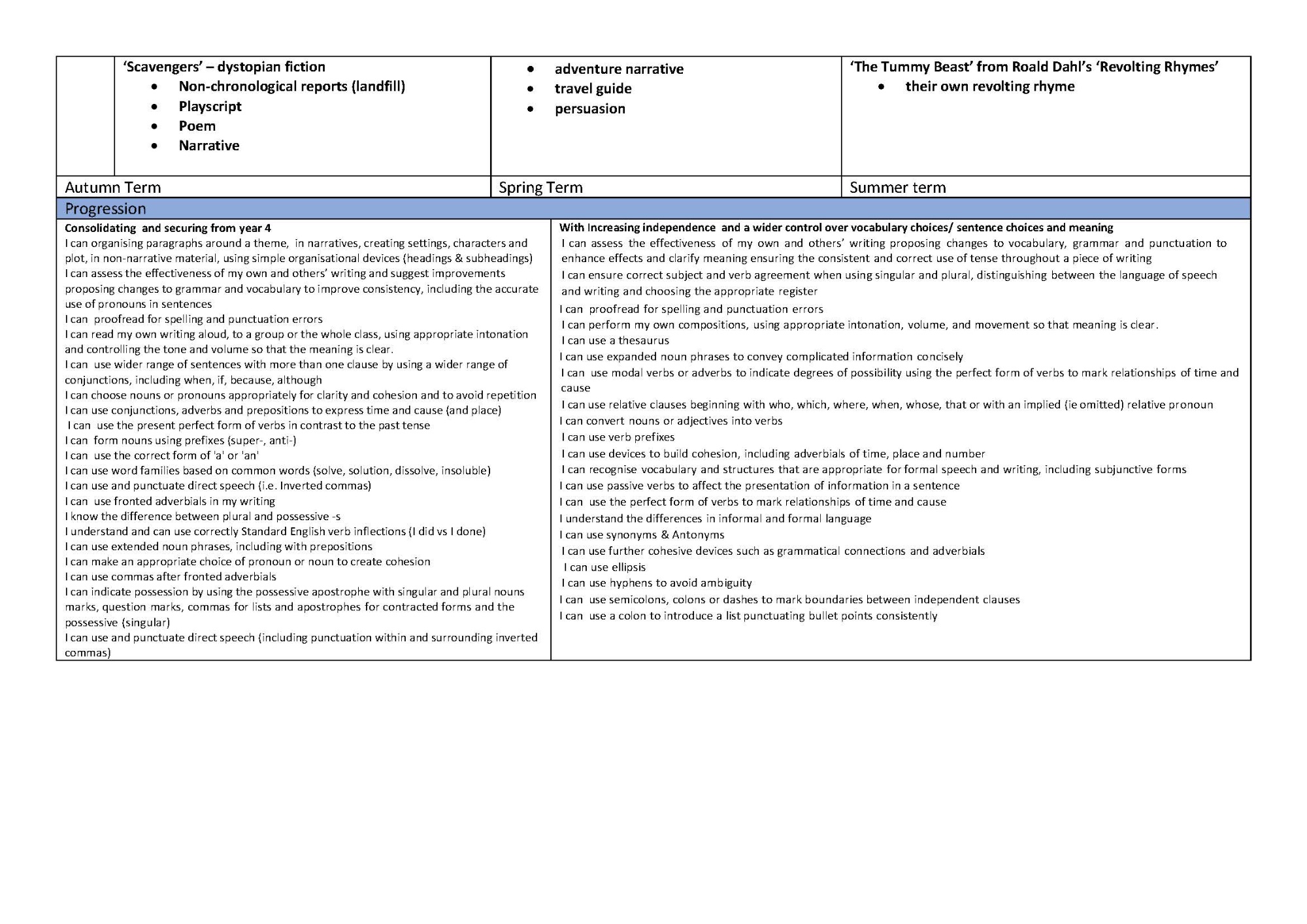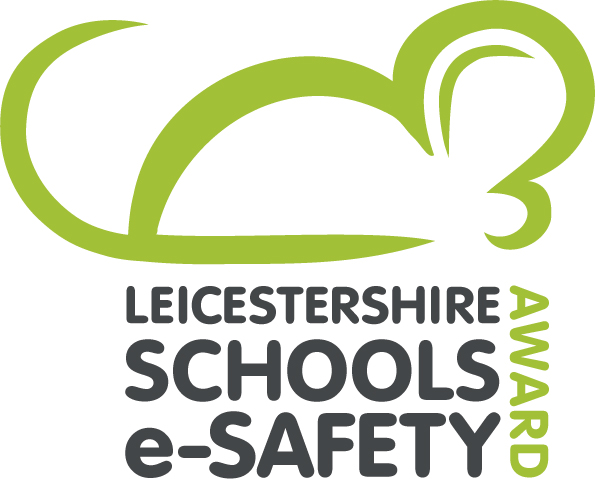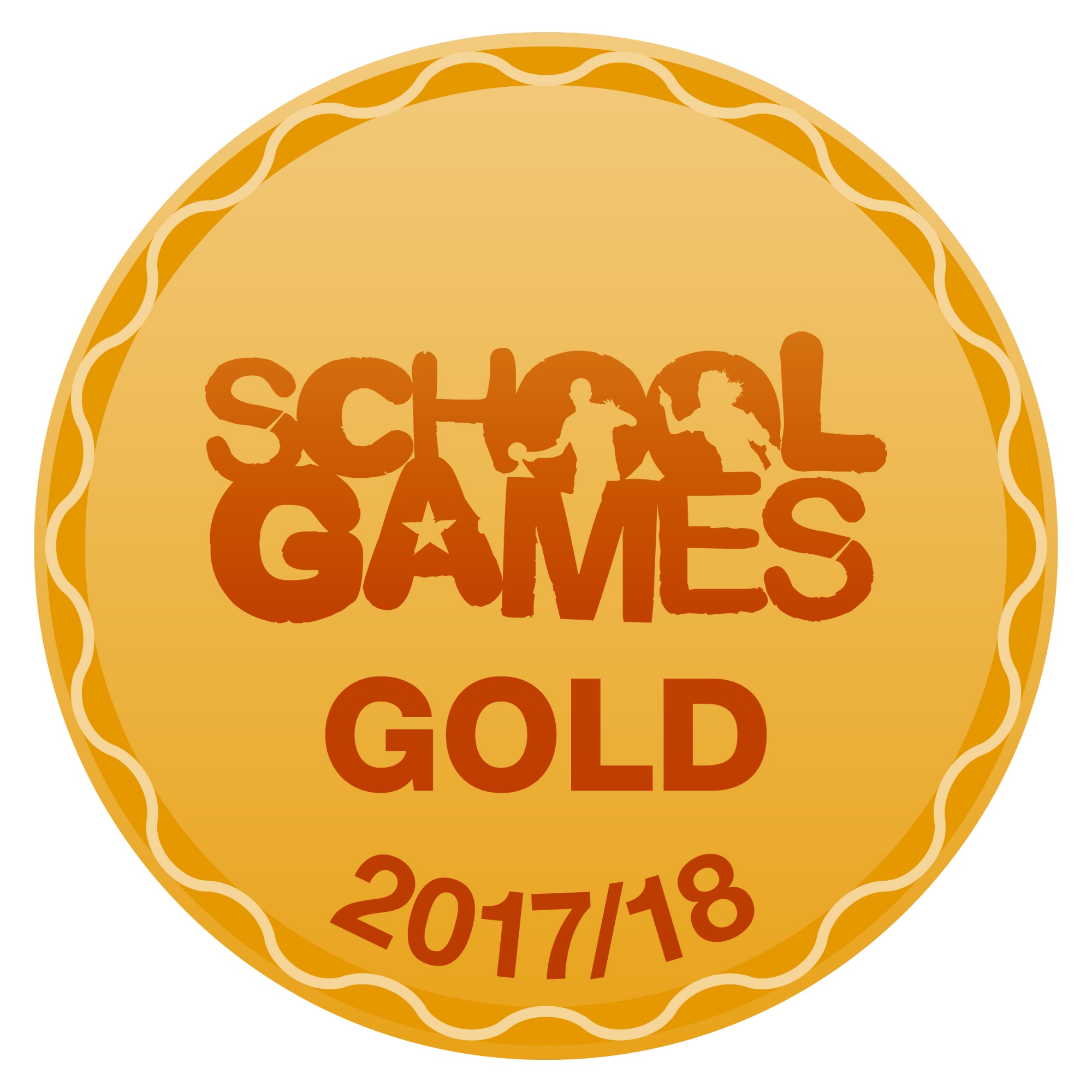ENGLISH (Writing, Handwriting And Spelling)
Together We Make Learning A Memorable, Unmissable Adventure
Preamble
English has a pre-eminent place in education and in society. A high-quality education in English will teach pupils to speak and write fluently so that they can communicate their ideas and emotions to others and through their reading and listening, others can communicate with them. Through reading in particular, pupils have a chance to develop culturally, emotionally, intellectually, socially and spiritually. Literature, especially, plays a key role in such development. Reading also enables pupils both to acquire knowledge and to build on what they already know. All the skills of language are essential to participating fully as a member of society; pupils, therefore, who do not learn to speak, read and write fluently and confidently are effectively disenfranchised.
The overarching aim for English in the national curriculum is to promote high standards of language and literacy by equipping pupils with a strong command of the spoken and written word, and to develop their love of literature through widespread reading for enjoyment. The national curriculum for English aims to ensure that all pupils:
- Read easily, fluently and with good understanding
- Develop the habit of reading widely and often, for both pleasure and information
- Acquire a wide vocabulary, an understanding of grammar and knowledge of linguistic conventions for reading, writing and spoken language
- Appreciate our rich and varied literary heritage
- Write clearly, accurately and coherently, adapting their language and style in and for a range of contexts, purposes and audiences
- Use discussion in order to learn; they should be able to elaborate and explain clearly their understanding and ideas
- Are competent in the arts of speaking and listening, making formal presentations, demonstrating to others and participating in debate.
At Newton Burgoland Primary School we study the National Curriculum for English in full.
WOW!
The Lady of Shallot – A narrative
Through the valleys and through the mountains, was home to an old creaky tower. The bricks were covered in moss and would shake during a storm. However, there was a girl, a young, beautiful girl. The town folk call her, The Lady of Shallot.
Although her life may seem more than perfect, in reality, her life was forever ruined and would never ever be fixed! For her life was cursed!
She wove all day and wove all night, she was bored and dreamt of climbing up a mountain as high as mankind, or bathing in the great crystal waters. But no, she can’t. The curse forbids her from doing everything she loves.
Until one stormy night, it had just turned midnight as The Lady of Shallot sat down ready to begin her new tapestry. She peered into her ancient mirror. As she stared, she noticed a knight in shining armour! She watched closely as he removed his polished gold helmet, releasing his chocolate-brown curls. His feather twirled as he rode along the gritty pathway. His pin badge shaking as she read the words, “Sir Lancelot.”
She stood up and walked back and forth. Back and forth. Her heart beating as quick as a tornado sucking up a house. She debated whether or not she should do the unimaginable. Look…out…the…window!
She thought dusk and dawn, dusk and dawn, about whether or not to do so. Her destiny was to meet Sir Lancelot in person after all. She got up, shaking. “One step at a time!” she repeated over and over again in her mind.
She took one last breath, committing to a decision, knowing she can’t turn back. She turned around slowly. The room began to shake and her mirror collapsed onto the floor…
She darted down the stairs, wishing for the best. “What have I done to deserve this?” she cried in sorrow. She was cold and wanted someone, anyone!
She tried to find a shelter, stumbling across an old rowing boat. She carved her name into the soft wood ‘The Lady of Shallot!’ she wrote, and lay down in the shell. She began to sing her final song as she rested calmly.
She slowly closed her eyes as people gathered round. They covered their mouths in disbelief as people began to cry.
Through the crowd a voice hurried to the front. “You are so beautiful, why must I see you this way? Sir Lancelot mumbled, “Please do not do this to me, you're far too amazing and wonderful to leave us!” the town began to applause as he saddled his stallion, weeping, weeping, weeping.
A narrative
The towers of Camelot loomed over the happy children and married couples as the colossal city gates opened and closed for a collection of jolly travellers, out of breath and panting.
Camelot was a trade centre and a hot spot for jobs and houses. The enormous walls wound through the countryside, embracing the city in a hug of protection and wellbeing.
However, just up the river from Camelot an elephant grey tower stood proud, over the meadows and rolling hills with its three other stone relatives looming beside it. Inside the tower a voice sang out, sound escaping, writhing, flowing down the steps from the highest room in the castle. The song sang, “four grey walls, four grey towers. Overlook a space of flowers, and the silent isle embowers The Lady of Shalott.”
The Lady of Shalott was a young maiden trapped in a crooked tower with no company. She spent her days weaving intricate patterns on a delicate loom. She had a tight corset, a white dress and a jewelled necklace. Unfortunately, there was a terrible curse upon her. If she was to look upon Camelot she would be punished by the dreadful curse cruelly.
This meant she could not make friends or play games; she was confined in a crumbling tower all by herself forever.
She was a local legend. Nobody had seen her stand at the casement window and only the farmers working hard in the fields and only the reapers reaping early could hear her mournful songs. But they thought it was the wind. Something never to follow or find.
It was a Friday morning. The grass was heavy with dew and the excited buzz of school children ready to finish the week was in the air. As always, the lady was looking at the reflection of Camelot in her crystal mirror; that was the only way she could see the outside world. She disliked her life and she hated watching everyone else live her dream everyday and they take it for granted! “I wish I could be playing with them. Weaving is so awfully boring.” She said to herself.
It was midday now and the sky had cleared of clouds and the silent breeze blew the barley gently, rocking it like a baby in a cot.
The Lady of Shalott was looking at the reflection of Camelot through the mirror, eyeing the townsfolk through keen eyes like a hovering kestrel. But then there were horses, glorious, magnificent horses with gallant knights perched comfortably on top of them, their armour squeaking as they moved towards Camelot. There was one knight in particular that caught her attention. He had oily black hair and a plumed helmet held in one cradled arm. He was a moustached man with jewelled armour and a long, sleek, iron sword polished to perfection and encrusted with rubies.
The lady of Shalott gasped and nearly fainted, “he’s perfect!” she sighed. Although her awe with anger. Why couldn’t she go and meet him herself! She let out an infuriated scream that no one would hear, that made her even more angry.
The clock chimed six long chimes and temptation got the better of her. She staggered one, two, three steps across the room and stared into the burning lamps and bonfires of Camelot’s nightlife!
The mirror cracked like lightning in a dark sky. The loom flew like a magic carpet out the now open window and into the river. the troubled young woman panicked and tore open the door and cascaded down the unused steps and on to the wet grass.
The sky was raging, the gods' very own curse had been almost cheated. She found a small punt boat on the side of the river bank and scratched her name on the side ‘The Lady of Shalott’ it read.
She clambered into the leaky vessel and loosened the anchor and the chain. It wasn’t long before she was drifting in the raging rain, cold, down the river, down towards Camelot.
The Lady of Shalott was shivering to the bone but she was hopeful. She would survive this, she told herself, but no matter how much she hoped, the only thing she could do was sing.
She was breathing quick in between shivers, her song disrupted by the wind. She then sung her last song, said her last words. I’ll find you sir Lancelot. And then she peacefully passed. Quietly. Quickly. Happily. This was the death she would want if death next to Sir Lancelot wasn’t an option. Down she floated past the barley and past the city gates and into Camelot, lifeless and limp.
The people of Camelot found it as a fairly nasty surprise. They had lowered heads and serious looks on their faces.
They stood there a long time. Listening to the rain and grieving. They say people grieve in different ways, but all the townsfolk were exactly the same apart from one sir Lancelot. The man in gleaming armour, his moustache, was quivering slightly, but he held it together and pushed to the front. “She has such a beautiful face. I wish I do not have to see her like this. What a wonderful thing, why did she have to pass?." Then he bent down and kissed her.
There was a half-hearted applause. Then Sir Lancelot cried.
Four grey walls, four grey towers. overlook a space of flowers, and the silent isle embowers, the Lady of Shalott.
y6 pupils 2024
handwriting
It is really important that children learn to write letters correctly so that they can develop a fluent writing style and begin to join.
Use these resources to help at home.
Spelling
In EYFS and key stage 1 spelling is initially taught within phonics.
When learners reach the end of the phonics scheme and are fluent readers they move onto the Babcock spelling scheme. (Usually in year 2)
The scheme continues in key stage 2 and has been chosen because of the focus on investigating to find rules and patterns - supporting memorisation.
Writing - Intent
At Newton Burgoland Primary School we want our pupils to acquire the necessary knowledge, skills and understanding to be able to communicate their thoughts, ideas and emotions effectively both independently and collaboratively. Writing is an integral part of our curriculum.
All children from Foundation Stage to Year 6 are provided with frequent opportunities to develop and apply their writing knowledge across the curriculum. It is our intention that pupils gain a clear understanding of the writing process in order to establish themselves as writer in their own right.
Through using high quality, engaging texts, we foster pupils’ interesting writing and offer a reason and context for writing, which enables the children to write for purpose and audience.
Children are expected to be reflective learners and to persevere by thinking about how they can make changes and keep improving their work.
It is our intention to broaden children’s exposure to high-level vocabulary and to allow them to apply their understanding of vocabulary and grammatical features across the curriculum.
Children are taught the relationship between words, word meaning, implied meaning and figurative language within writing lessons, whilst ensuring they are supported in their spelling strategies.
Implementation
At Newton Burgoland Primary School, we teach writing by starting with high quality engaging texts from a range of authors, genres and cultures. We place a high importance on exposing and teaching children a wide range of vocabulary in order to help them acquire a large vocabulary bank to call on. Author’s choice of words, phrases and sentences are highlighted and scrutinised:
- How would the meaning of the text change if X was substituted for Y?
- How positive/ negative is the author’s choice, why?
- How could you use this in your own writing?
We ensure children have a solid understanding of grammar and are able to spell new words by effectively applying the spelling patterns and rules they learn throughout their time in primary school. We want them to write clearly, accurately and coherently, adapting their language and style in and for a range of contexts, purposes and audiences
Through our ‘teaching texts’, and other high-quality texts, teachers deliver writing sequences that build up children’s writing composition skills by focussing on sentences, phrases and vocabulary.
Writing sequences cover a range of genres and specific purposes, and all sequences end in a piece of independent extended writing at least once within a 2/3 week sequence of work.
In classrooms, teachers support children’s writing composition and technical skills by using ‘working walls’ that look at the effect, ingredients and examples of writing that meet the sequences purpose. Children are encouraged to ‘magpie’, experiment and apply. Working walls include but are not limited to: A WAGOLL, vocabulary, sentences and purpose. High quality pupils work is also displayed.
Teachers will, at times, link the purpose of their writing to the theme they are studying so children experience quality-writing opportunities across the curriculum. At times, children will revisit a text type, they have been taught, to show their learning across the curriculum.
Teacher ensure they cover a wide range of text type and genre across the year using our genre progression to guide them. They ensure the units they plan and deliver consist of:
- Fiction: 18 weeks: 4/5 3 week units across the year
- Non-fiction: 12 weeks: 4, 3 week units – organised to suit the curriculum
- Poetry: 6 weeks: 2, 3 week units
Within all units exemplar texts maybe drawn from fiction, non-fiction and poetry.
Teachers use our English Progression Map to ensure they teach and revisit the Key Objectives in writing. These are broken down into termly expectations. These Writing Expectations provide a clear end point for writers as they move through the writing curriculum.
Writing assessment frameworks support teachers to target intervention and support where it is most needed.
In every classroom, we ensure vocabulary knowledge is explored and developed. Teachers use a vocabulary display board to develop and define vocabulary that children discover through the teaching texts, guided and whole class reading sessions and whole class story from our reading spine. We also celebrate and encourage children to explore vocabulary in all areas of the curriculum.
Spelling strategies are taught to children through the ‘No Nonsense Spelling’ programme (y2 – Y6) this allows us to ensure children are developing the correct spelling knowledge as they move through the curriculum.
We believe that all pupils should be encouraged to take pride in the presentation of their writing, in part by developing a good, joined, handwriting style by the time they move to secondary school.
Teacher follow the letter join Handwriting Scheme, which has been adapted to meet the needs of children in our school, to ensure a progressive and consistent approach across the school.
Planning Units of work for writing
Step 1: The teacher selects the text and the outcome and prepares a WAGOLL
This enables an initial plan (teaching sequence) to be drawn up based upon the expectations for the year group combined with previous assessment information.
Step 2: Assessment/ elicitation task ( cold write)
This is a writing task that may be used, at the teacher’s discretion, to identify starting points for the text type. It needs to be completed before the children start the sequence so that their writing can be analysed and the sequence adapted in light of the children’s needs.
Support should be given in terms of the content to be written about but not how it is written. Tasks need to be engaging and the children need to have something to say.
This writing is used alongside the outcome to identify progress across the teaching sequence and any pupils needing support to work at the expected level for the year group (i.e. to achieve objectives from the previous year group).
Step 3: Reading into writing – Book talk/ understanding the WAGOLL
The purpose of this stage is to capture the children’s interest and help them get to know the text really well. This is through both ‘reading as a reader’ – exploring and sharing personal responses to what they read – and through ‘reading as a writer’ – recognising and investigating the features the writer uses to engage and manipulate the reader. (literary devices, sentence length, word choice). Pupils are supported to understand the authors choice and to ‘play’ with ideas. Comparisons may be made with other texts to support pupils to develop a menu of choices they can draw upon at the point of writing.
At this stage key plot points/ text organisation strategies are identified and in narrative whether or not these points are positive or negative. This step will often involve some form of learning and remembering of trickier or interesting sections to be used as an initial model for writing. Children will innovate their own text using these plot points / text organisation strategies at the end of the unit of work, but will be given the opportunity to select the text type they wish to write when appropriate.
It is key that Book Talk is planned to be appropriate to the age group and text. For a longer text book talk may be used across the unit of work combined with short burst writing. Therefore, writing opportunities, related to the Writerly Toolkit are planned as way for children to practise a concept or skill that can later be applied to their Practising or Independent Write.
Copies of writerly toolkits are kept by pupils so they can be referred to when writing across the curriculum.
KS 1
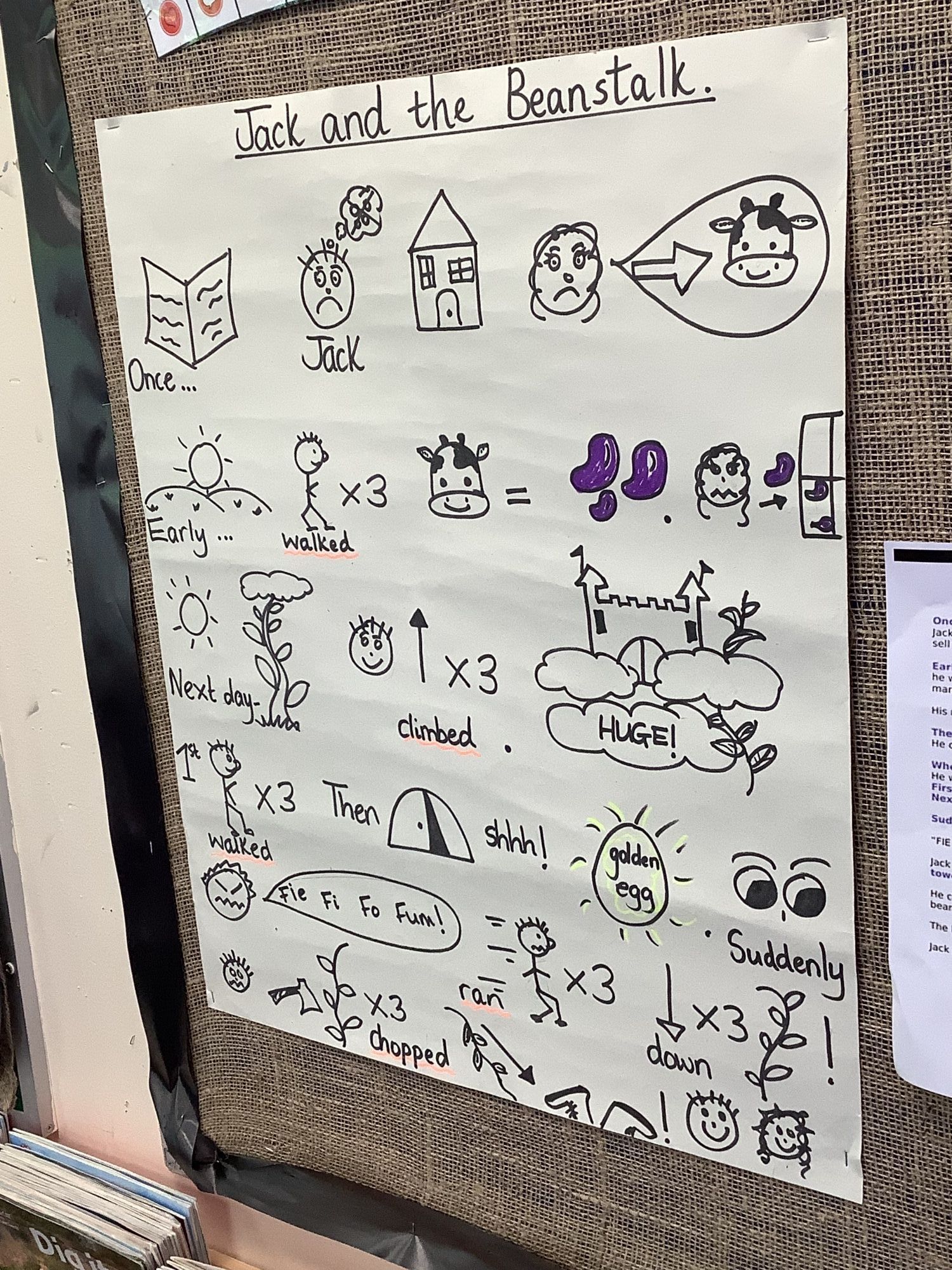
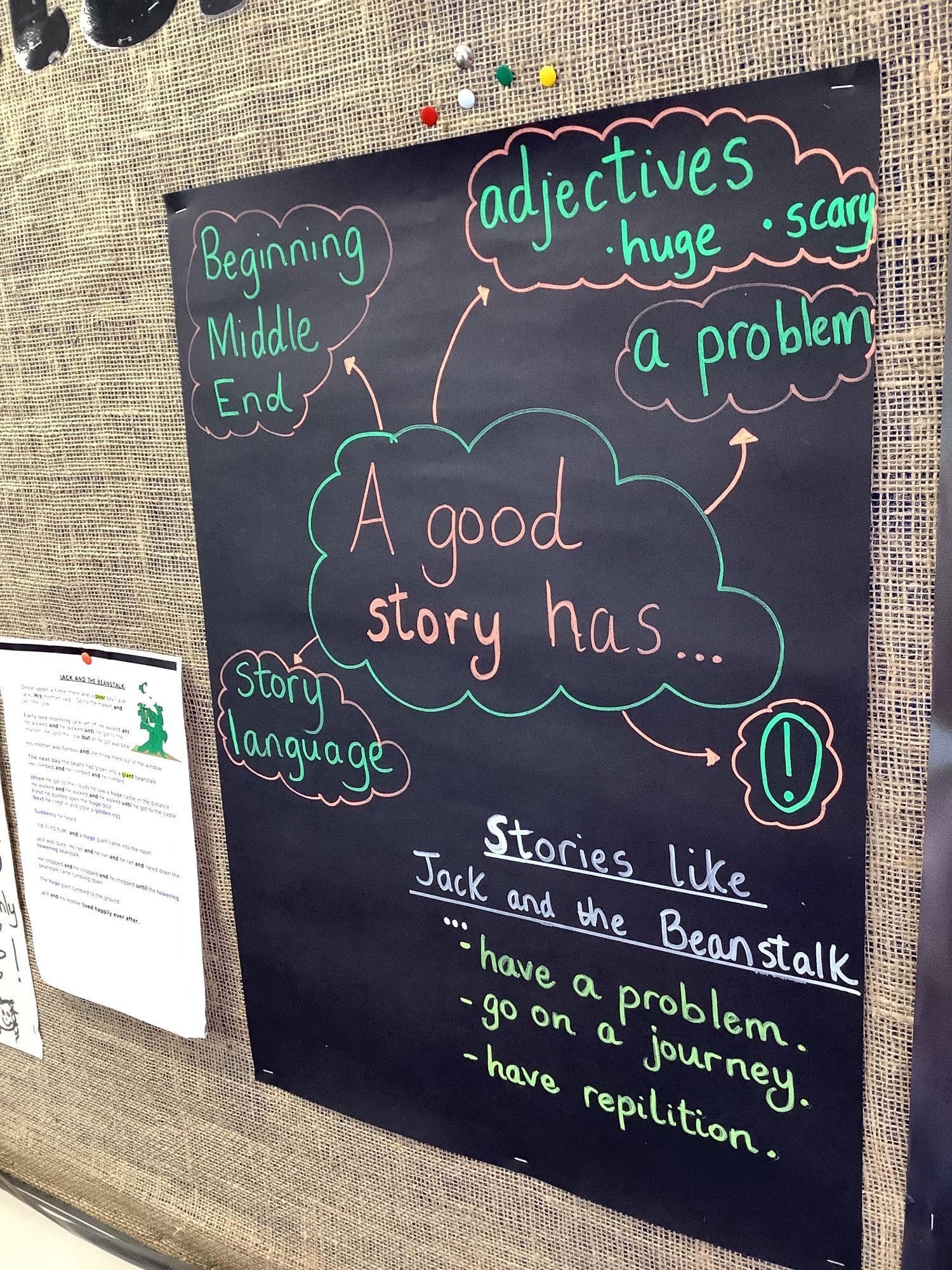
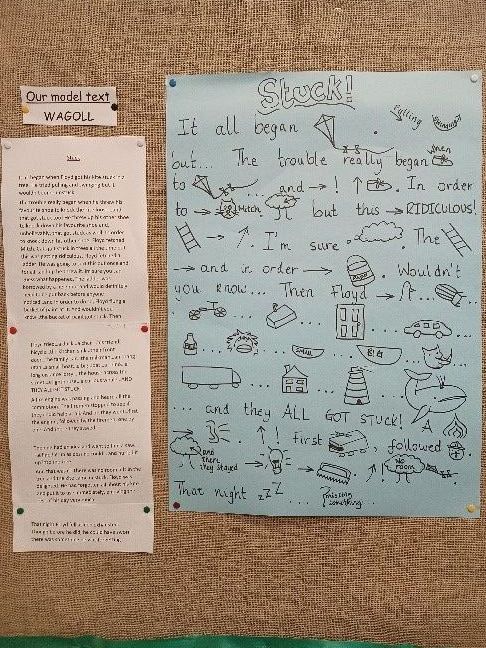
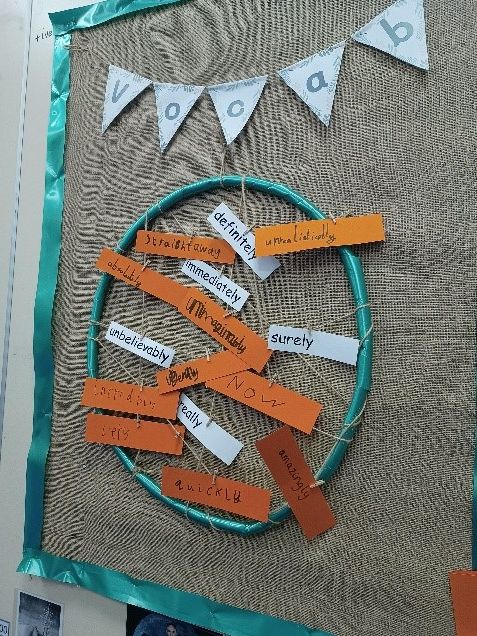
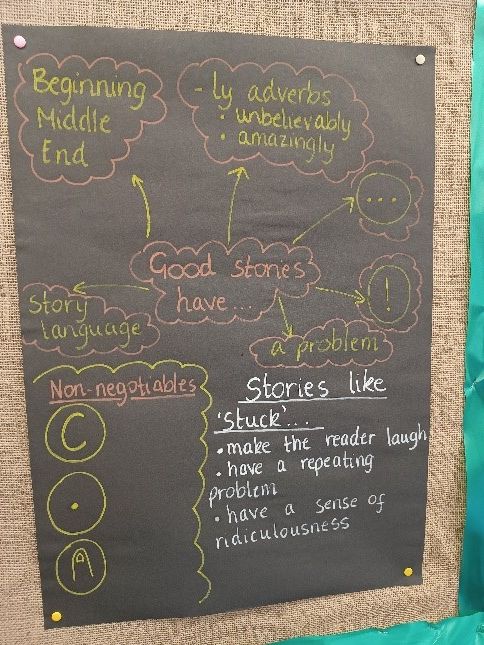
KS 2
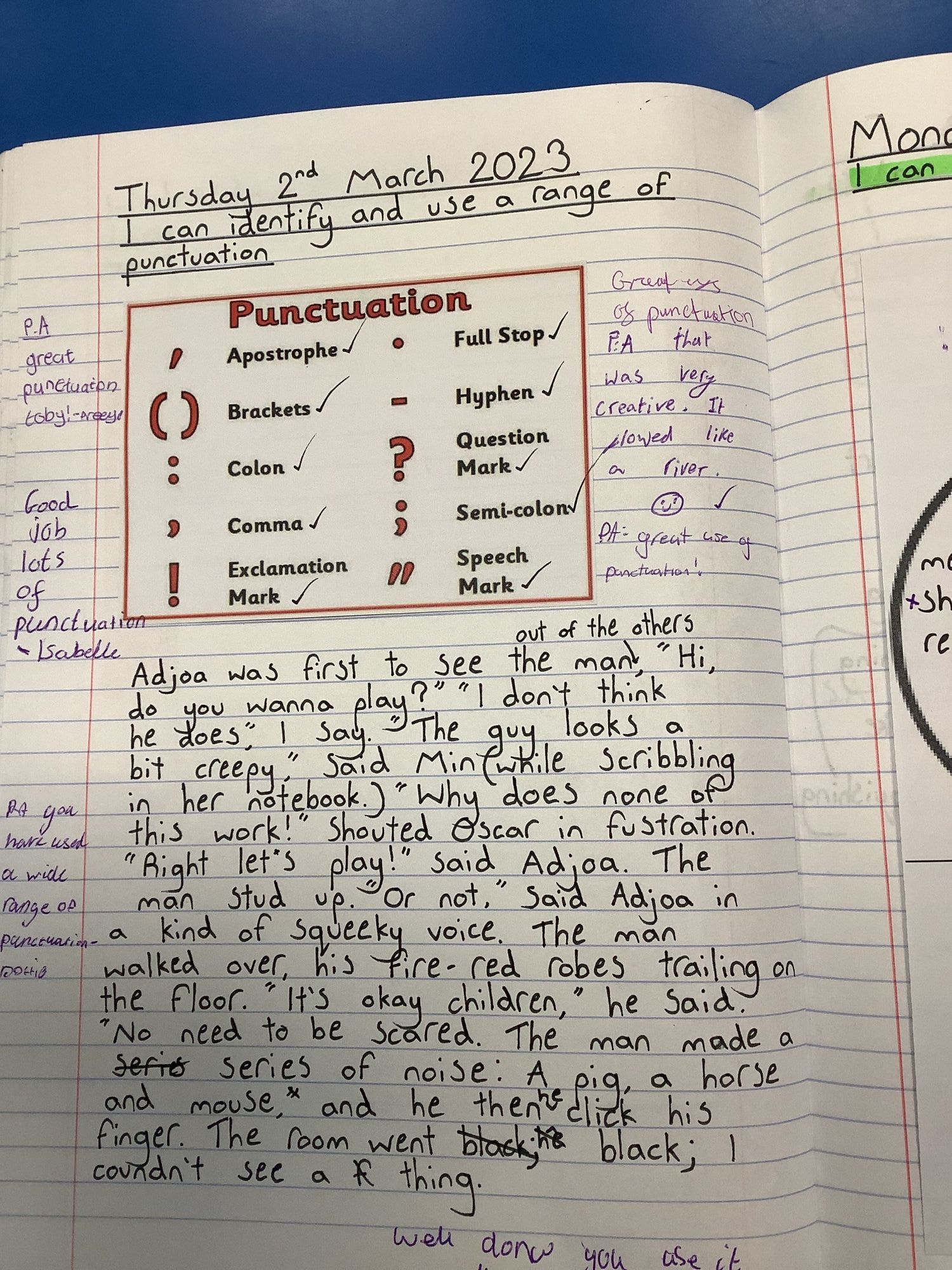
Each sequence will contain some or all of:
- a hook into the text
- reading and responding to the text/ understanding the WAGOLL
- comprehension activities
- retelling the text
- talking about the text
- in role in the text/drama
- vocabulary work
- Sentence work
- analysing the text including the authors use of literary devices
- grammar and punctuation in context
- identifying the structure of the text
- story mapping and retelling
- comparing the text to others
- Collecting and recording ideas
These activities often contain some element of writing to record process, outcome or learning.
Step 4: Short Burst writing – shared writing
When writing pupils will have access/ age appropriately to:
- Tricky word mats
- Grow the code
- Statutory spelling lists
- Dictionaries and thesauruses
- Sentence support
They are taught to access these independently and are expected to automatically get out their writing toolkit across the curriculum.
During this stage, children need to try out the elements of writing they are less sure of so that they can use this experience when writing independently. This means they need opportunities to play around with the language and structures they’ve been learning about and will be supported by their teacher(s).
In teaching sequences, this section tends to include:
- Focussing on individual plot points, analysing author choice and impact, generating ideas to write about , vocabulary, phrases and sentences
- recording key ideas alongside the structure of the text
- telling and talk to generate the text
- Sentence work, including grammar
- Modelled and shared writing followed by paired or individual writing – innovating at sentence and paragraph level
- Think alouds by the teacher to model metacognition and the writing process, including editing
- editing
Shared writing supports:
- modelling writing the text, usually in sections applying learning from the first phase
- children writing their own version of the text using the class idea
- editing writing
- proof-reading writing
Step 4: Independent writing - innovation
Children are supported to plan their own piece of writing based on the text they have been working with.
Examples of innovation include:
- change of setting
- change of character
- change of text type
Using the writerly toolkit, story map or text structure diagram, children plan their own piece of writing. They plan how they will apply their learning
Example planning sheets:
Narrative:
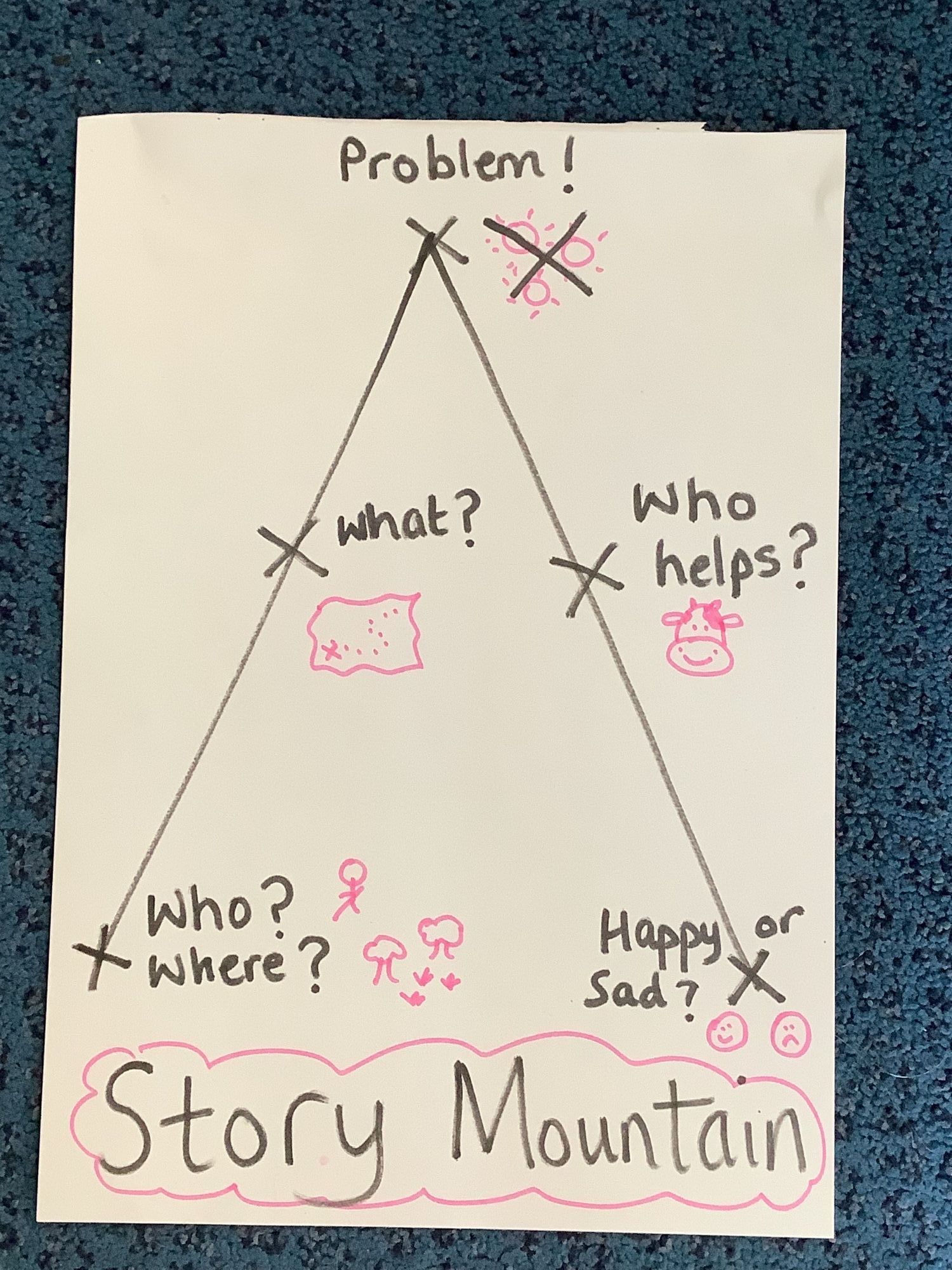
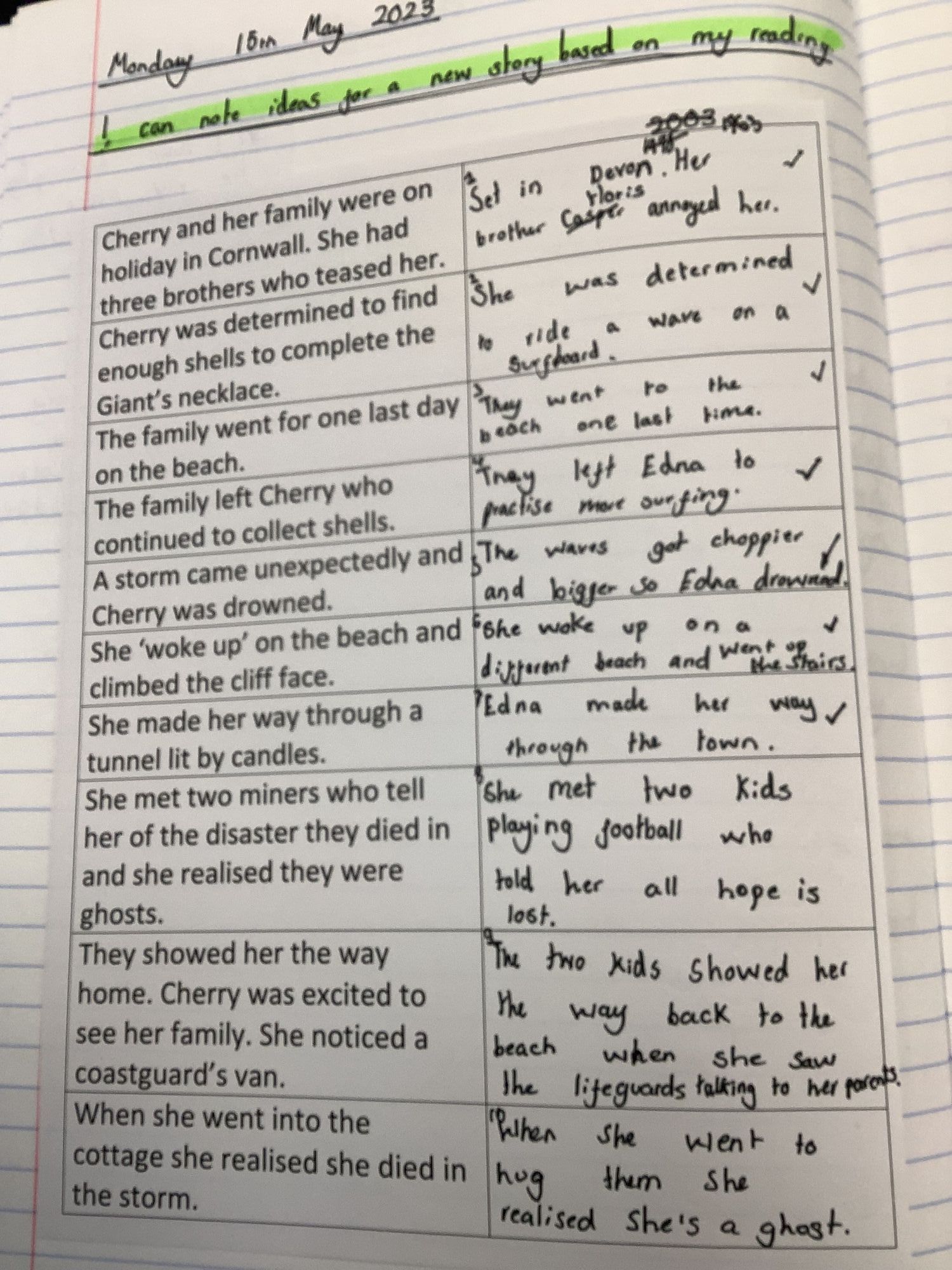
Stage 3 / 4 Final piece/ Editing
Children draft and edit chunks of writing – several lessons maybe needed so that children edit as they write and feel they have the time needed to do this. Editing may be done electronically.
Step 5 Assess
Pupils will self- assess against the unit expectations to identify successes.
Teachers will assess to identify next steps or where support is needed.
Our curriculum Drivers in writing
Reading
All units of work include reading into writing. We read, analyse and draw on ideas from texts to write for ourselves. Learners read their own work to edit and share success.
In writing, it is our intention to provide opportunities for learners to explore words, develop phrases, play with sentences and paragraphs meaning that they learn to consider the impact on the reader when they write. We encourage children to become effective not formulaic writers and draw on models from reading and manipulate them for their own purposes. Children are taught how to improve their work, using proof-reading, to check for accuracy, spelling and grammar.
Character
The best writers are resilient, they are happy to make mistakes as part of the process of writing. Great writers respect the work of others and support each other kindly.
In writing, learners develop sensitive awareness of, and the ability to respond constructively to, the backgrounds, experiences, concerns and feelings and commitments of others through poetry, imagery, drama, role-play, myth and historical narrative in order to build their own understanding of world events.
Creativity, reasoning and communication
Writing is a creative process. In the early years learners share their stories orally, experimenting with language and sentence structure. Within units of work learners discuss and debate, creating stories and non-fiction texts together before working independently.
Impact
Our learners returned to school following school closures with less stamina for writing. They needed support to re-establish a fluid joined handwriting style in key stage 2 and to learn statutory spellings and apply them in independent writing.
At the start of 2023/24 we are confident that pupils are able to produce beautiful written work. They are using the tools available to help them to spell well, and they are drawing on model texts to write independent and creatively.
Our goal going forward is to support more pupils to achieve the higher standard at the end of year 6 and for all pupils to write for both pleasure and to learn.

